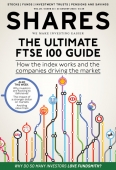Archived article
Please note that tax, investment, pension and ISA rules can change and the information and any views contained in this article may now be inaccurate.
Geared for growth: how to use ‘gearing’ as a debt check tool

When most people think about debt they usually see it as something to avoid. Personal loans, credit cards bills and often hefty interest charges will typically spring to mind.
It is often the same with investors. Companies with large debts have a nasty habit of coming a cropper, as Carillion demonstrated earlier this year.
But to grow a business to the benefit of its shareholders debt comes in very handy, and is often absolutely necessary. The trick is for a company to manage its borrowings smartly, and investors can judge this by monitoring ‘gearing’, or in other words, how much debt it is carrying relative to its equity.
DEBT TO EQUITY RATIO
In simple terms, the debt to equity ratio tells investors how much debt is being used to run the business, or how much debt the company has for every pound of equity shareholders own.
Calculating a company’s debt to equity ratio, or gearing, is straightforward enough. Take a company’s total liabilities (what it owes third parties) and divide it by equity. Equity is usually referred to as ‘Shareholders’ funds’ on a balance sheet, and it tallies perfectly with the company’s net assets, which is what’s left of assets after debts have been taken off.
The formula looks like this:
Before we go on, let’s have a quick look at the important bits of a balance sheet. They contain three parts: assets, liabilities
and equity.
BOTH SIDES OF THE BALANCE SHEET
Assets and liabilities come in two flavours: short-term, usually to be repaid in less than a year (current assets/liabilities as accountants call them) and longer-term which is money due in more than a year’s time (non-current in number crunching jargon).
Current assets include cash and anything else that can be quickly turned into cash, items like stock for sale or financial instruments perhaps used to hedge against currency movements.
Longer-run assets include property and machinery plus goodwill. Goodwill can be virtually anything that is difficult to value, areas like strong customer relationships, well developed supplier networks or the value of a trading brand.
Current liabilities may include short-term loans, goods and services received but not yet paid for, and sometimes upcoming dividends.
Similarly, non-current liabilities are borrowings that needn’t be repaid within the next 12 months plus other future payments, perhaps predicted pension contributions or tax bills.
SHAREHOLDER’S FUNDS, OR EQUITY
Shareholder’s funds are basically everything else that does not fall into the assets or liabilities buckets. This is effectively what shareholders own.
Typical items include accumulated profits over the years and the money put into the company by investors, shown as issued share capital and the share premium account, although there may also be various reserves as well.
Let’s use the previous equation and fill it in with some values.
Say a company in which you own shares has liabilities of £12.5m (in other words owes £12.5m) and has shareholder’s funds of £10.5m.
So the debt to equity ratio here would be 1.19. When analysts or investors talk about gearing it is this same equation but expressed as a percentage, or 119% in this example.
Let’s use some different values, say £1.65m of debt versus £2.75m of equity.
In this example the debt to equity ratio comes out at 0.6, while gearing stands at 60%.
NO CATCH ALL RULE
There is no hard and fast rule about how much debt any single company should carry as it depends on a multitude of factors. More debt might imply expansion, the development of new product lines or a very reliable cash flow stream from customers – energy companies are good examples of the latter.
Lower levels of debt might equally mean that a management team is being too cautious or is becoming increasingly nervous about the future. Zero debt and lots of cash on the balance sheet, while seemingly very conservative, could see a company targeted by a takeover predator.
While individual company debt needs to be assessed on
its own terms there is a rough rule of thumb for gearing. Lower than 50% is widely considered comfortable, more than 50% is aggressive, higher than 75% is excessive.
BUYING A HOUSE
To understand why let’s put this into consumer terms – a mortgage. Say you buy a house for £200,000. You put down a £20,000 deposit and borrow £180,000. If house prices rise by 10% your place is now worth £220,000.
But your debt is still £180,000 so your equity is now worth £40,000. On a 10% capital increase your equity has doubled.
Sounds great, but this ‘leverage’ also works in reverse. Spin that example round by saying house prices drop 10%, it would completely wipe out your equity.
There are other implications too. If you get severely financially stretched to the point of having to sell your house the implications are even worse since you’d be crystallising the loss of equity. And if house price declines were steeper than 10%, such as by 15% – you’d be left still owing £10,000 to the bank even after the house is sold.
The lesson is clear; debt can be a very useful tool in business and creating value for all shareholders. But TNT is useful for demolition and some types of mining, but you wouldn’t be flippant with sticks of dynamite. (SF)
Important information:
These articles are provided by Shares magazine which is published by AJ Bell Media, a part of AJ Bell. Shares is not written by AJ Bell.
Shares is provided for your general information and use and is not a personal recommendation to invest. It is not intended to be relied upon by you in making or not making any investment decisions. The investments referred to in these articles will not be suitable for all investors. If in doubt please seek appropriate independent financial advice.
Investors acting on the information in these articles do so at their own risk and AJ Bell Media and its staff do not accept liability for losses suffered by investors as a result of their investment decisions.
Issue contents
Big News
- Hill & Smith directors take advantage of profit warning-led share weakness to snap up stock
- Investors shift focus to defensive stocks
- Pressure on corporate brokers implies potential wave of M&A
- Trump attacks the US Federal Reserve
- London hoteliers set to report bumper numbers following July heatwave

 magazine
magazine











